Kitchen Equipment
Here is a list of what you may need for making your own bread in your kitchen.With my experience, I rated the equipments with one to five stars according to their nesessities.
Thermometers

Dough thermometer
( Ondokei )
The Room Thermometer measures the room temperature around your workspace. The Dough Thermometer measures the temperature of flour, water and dough, and can touch the ingredients.
A good starting point is to have a water temperature* of 24∼28℃ in summer, 30∼34℃ in winter, and 28∼30℃ during moderate seasons. If you are more experienced baking bread, it is better to calculate* the water temperature, considering room and flour temperatures.
*These temperatures are suitable for Straight Dough Method.
*To calculate the water temperature, please see the related page of Crumb and Crust.
Scale

Digital scales
( Hakari )
A digital scale for up to 2 kg is useful for bread baking at home.
Many recipe books available in Europe and U.S. tell you to measure the amount of ingredients, however, it is always best to weigh out the ingredients when baking bread. Flour, sugar and salt can easily be affected by humidity, so weight will vary depending on your kitchen condition.
Measuring Cup

200ml Cup
( Keiryou Cup )
1 cup in Japan is 200ml, whereas a rice measuring cup in Japan is 180ml.
Measuring Spoons
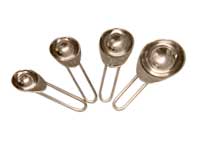
Measuring spoons of 1/2tsp, 1tsp, 2tsp, 1tbs
( Keiryou Spoon )
Japanese 1 o-saji (tablespoon) measures 15ml and 1 ko-saji (teaspoon) measures 5ml. However, these measurements are slightly different from 1 Tbs and 1 tsp in other countries.
Electrical Mixer

Famous American electrical mixer
( Denki Mixer )
A semi-professional dough mixer with a dough paddle attachment. It is useful if you like to mix a large amount of ingredients at once, but you will not need it unless you bake everyday.
Fooc Processor
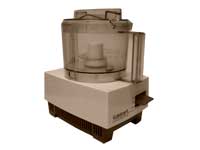
Famous American food processor
( Food Processor )
It is handy for making purées or mousses that can be mixed into the dough or spread onto French bread. Some of larger food processors can be used as dough mixer. However, there is a risk of damage to the motor, since the dough is can become quite thick.
Mixing Bowls

Mixing bowls in four different sizes
( Bowl)
Wooden or plastic bowls are better than stainless ones to allow the yeast to rise, although differences are minor. If you are using the Straight Dough Method at home, use a large bowl that is not too high (so that it will not take long time for fermentation).
Rattan Basket
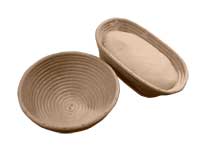
Rattan baskets without lining
( Hakkou Kago)
A traditional coiled rattan basket is used for the final rising of dough of such bread like pain de campagne ("French country bread"). There are also baskets with canvas or linen lining. The basket is best used for rye bread, which requires air circulation and tends to loosen up during the final fermentation.
You should dust it with plenty of flour before placing dough in it. After using it, you should clean it with a brush without any water or detergent, and leave it in the sun to let it dry completely, particularly in humid weather.
For bread baking at home, you can enjoy freely making your own shape of bread, and rattan basket may not be needed.
Couche ( Canvas )
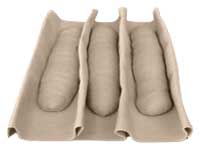
Dough on Couche
( Couche )
A heavy canvas sheet of "Bed" (Couche in French) for bread. It is dusted with flour and used to support freestanding loaves, such as baguettes, while they are fermenting. It is not used for bread like croissants.
After using it, you should clean it with a brush (or just shaking is sufficient) without any water or detergent, and let it dry in the sun.
Plastic Wrap and Shower Cap
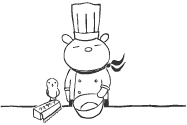
Let the dough rise with the plastic wrap on.
( Wrap and Shower Cap )
To prevent your dough from drying out, plastic wrap is handy. You may need it during fermentation, rising and dividing the dough.
Plastic wrap is also useful in softening butter. To do this, wrap butter in a piece of plastic wrap, and rub it between your fingers for a minute or two.
As backup, a shower cap can be used in place of cling wrap, and may even fit better onto a dusty bowl.
Refrigerator

Refrigerator
( Reizouko )
Dough for rich breads like croissants needs to be kept cool overnight, before layering with butter. The temperature should be kept around 5℃ since dough will start fermenting at temperatures above 8℃.
When layering butter, dough should be kept cool at all times to avoid melting. Keeping some space in your refrigerator beforehand is a good idea.
Oven

My Favourite gas oven
( Oven )
There are some ,tips to bake delicious bread with a household oven.
You should always preheat the oven 5 to 10℃ higher than it needs to be, in order to adjust for the heat loss while opening the door (and misting) as you insert loaves, and then turn down the temperature once loaves are set. It is important to keep a separate oven thermometer in the middle of the oven, to ensure an accurate temperature.
It is also recommended to create steam in your oven (could be by misting with a spraying bottle) if you are baking lean breads such as baguette.
A proof function may be available in Japanese domestic ovens.
(Warning: Never spray the oven light and glass part, as they may shatter! Read the direction of your oven carefully and follow all use and care instruction).
Oven Pan and Baking Stone
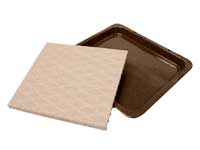
An oven pan and a small baking stone
( Tenban and Baking Stone)
If you are baking lean bread, first preheat the oven and then preheat the pans in the oven before placing the loaves in the pan.
(Warning: Use an oven mitt to handle the hot pans to avoid burning yourself!)
Leave a gap between each loaf or roll in the pan to allow for expansion.
If you are serious about your artisan bread, use a baking stone, which should be set and preheated in the oven. When it is hot enough, slide the loaves onto it.
Baking Sheet

Bread on re-usable sheet
( Oven Sheet )
Baking sheets are used when baking dough without loaf pans.
A wide variety of baking sheets are available, such as rolls of paper and re-usable silicon mats. Silicon mats are economical, as they do not have to be greased every time you bake, unlike oven pans.
Spraying Bottle
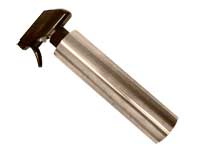
A must have for baking lean bread
( Kirifuki )
A spraying bottle is used to create steam in the oven when baking lean bread dough. Steam allows loaves volume as well as a thin, glossy and beautiful crust.
Mist the walls around the door of the oven with a bottle, and directly on the dough as you insert it to the oven.
(Warning: Never spray the oven light or glass parts, as they may shatter. Follow your oven’s directions carefully if you are concerned.)
Tart Stones

Tart stones on baking tray
( Tart Stones )
Tart stones can be used to create steam in the oven. The oven pan with tart stones scattered on top may be placed on the lower rack of the oven. First, you preheat them, and then carefully pour in hot water after putting your loaves in the oven
(Warning: Pay special attention not to burn yourself on the hot water, oven pan and tart stones. Read the direction of your oven carefully and follow all use and care instructions).
Loaf Pan
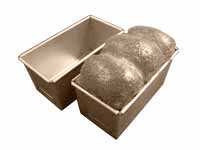
One-loaf pans without lids
( Shokupan-gata )
A variety of loaf pan sizes are available, including half-loaf, single loaf, one-and-half loaf, and two loaf. They all come with lids to slide on top.
For square-type bread, bake it with the lid on, and for English-type bread, bake it without the lid. Be sure to grease these pans well.
If you have a small oven (a typical Japanese household oven), you can substitute a cake pan for a loaf pan.
Cake Pan

Round and square cake pans
( Cake-gata)
Cake pans are used as substitutes for loaf pans, brioche pans, and any other kinds of bread.
You should check the size of your oven before buying any pans to be used for bake goods.
Knives

Four knives you need
( Houchou )
Knives required for making bread are; a large knife (to cut the flat dough of croissant, etc.); a small paring knife (to cut fruit that garnish pastries); a palette knife (to spread cream on dough); and bread knife (a must for slicing larges loaves).
Cutting knife, scissors, and Baker's Blade

From top to bottom, a cutting knife, scissors, and baker's blade
( Cutter, Hasami and Rum)
A cutting knife, baker’s blade, and sharp scissors are used to cut or score loaves and rolls.
A baker’s blade has a separate handle, and while not easy for beginners to use, can make beautiful patterns on baguettes and similar French lean breads.
For making bread at home, a sharp cutting knife and scissors will meet most of your needs.
Dredge and Dough Cutter
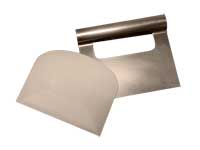
A dredge(card) and a dough cutter with a grip
( Card and Skepper )
A dough cutter and a card are must haves for those who knead dough by hand.
A dough cutter is versatile, as it can be used for mixing, dividing, and even freeing up workspace.
A dredge (card) is also a very convenient item, as it can be used to take your dough out of a mixing bowl, place your dough into a pan, shape your dough, and many more.
Whisk
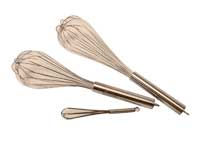
Whisks in three sizes
( Awatate-ki )
A whisk is well known for whipping cream. However, if you are using multiple flours for one bread, then it is best to whisk the flours together to aerate and mix them. Afterward, they should be sifted before use.
Table Brush and Pastry Brush

My Faivourite French table brush and pastry brushes
( Table Brush and Hake )
A table brush can be used to clean up your workspace, as well as to remove dust from loaves before glazing.
A pastry brush is used to paint loaves and pastries with an egg glaze before baking. It can also be used to garnish baked breads. At least one medium-sized pastry brush is recommended.
Flour Sifter and Tea Strainer

A flour sifter and a little tea strainer
( Furui and Chakoshi)
Flours should always be mixed and sifted, as flour is typically packed very tightly. Dusting flour, for example, can be re-used as long as it is re-sifted each time.
For decorations, a tea strainer is sufficient for sprinkling icing sugar on the bread and giving a professional appearance.
Rollin Pins
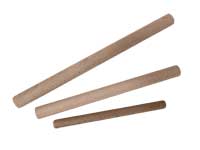
Rolling pins in three sizes
( Men-bou )
Rolling pins are used to flatten dough for croissants, pizzas and many other pastries. It is convenient to have both a small and large rolling pin.
Cooling Rack or Wore Grate

A cooling rack (22cm in diameter)
( Coke-cooler )
A cooling rack or a wire grate is ideal for cooling your baked goods. The air circulation underneath the loaves allows excess gas and steam inside to evaporate, making the crust crispy.
Any sort of bread that has just come out of the oven should rest on a cooling rack or a wire grate before eating; otherwise you might get an upset stomach.
Workspace

Hight is important for kneading!
( Sagyou-dai )
The best workspace for making bread is a smooth wooden surface, as it maintains the dough temperature during mixing and kneading. However, for homemade bread, the most important consideration is having the right height and space to knead comfortably.
Oven Mits and Thick Gloves

My mitte and a typical Japanese thick glove
( Nabe-tsukami and Gunte )
Japanese gunte gloves (thick cotton gloves) are ideal to handle hot bake goods, and they can be put on underneath traditional oven mits.
Bread Proofer
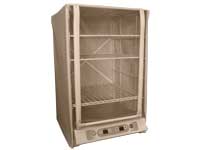
A Japanese household bread proofer
( Hoiro)
A (Japanese) bread proofer is used for the final proofing of dough. It can control the proofing temperature and time, keeping ideal humidity so that your bread will rise under stable conditions.
If you do not have a bread proofer, you may be able to use your oven instead, or simply use what you have.
More information about fermentation and proofing, please see the related page of Crumb and Crust.